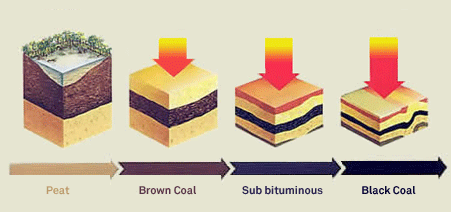Coal Overview
What is Coal?
Coal is a combustible, sedimentary, organic rock formed from ancient vegetation which has been consolidated between other rock strata and transformed by the combined effects of microbial action, pressure and heat over a considerable time period. This process is referred to as 'coalification'.

Layered between other sedimentary rocks, coal is found in seams ranging from less than a millimetre in thickness to many metres. Coal is composed mainly of carbon (50-98%), hydrogen (3-13%) and oxygen, and smaller amounts of nitrogen, sulphur and other elements. It also contains a little water and grains of inorganic matter that remain as a residue known as ash when coal is burnt.
How was Coal Formed?
Initially peat, the precursor of coal, was converted into lignite or brown coal - coal types with low organic 'maturity'. Over many more millions of years, the continuing effects of temperature and pressure produced additional changes in the lignite, progressively increasing its maturity and transforming it into the range known as sub-bituminous coals.
As this process continued, further chemical and physical changes occurred until these coals became harder and more mature, at which point they are classified as bituminous or hard coals. Under the right conditions, the progressive increase in the organic maturity continued, ultimately to form anthracite.
Large coal deposits only started to be formed after the evolution of land plants in the Devonian period, some 400 million years ago. Significant accumulations of coal occurred during the Carboniferous period (350-280 million years ago) in the Northern Hemisphere, the Carboniferous/Perm ian period (350-225 million years ago) in the Southern Hemisphere and, more recently, the late Cretaceous period to early Tertiary era (approximately 100- 15 million years ago) in areas as diverse as the USA, South America, Indonesia and New Zealand.
- Coal Mining
- |
- Coal Crusher
- |
- Coal Mill
- |
- Coal Classification
- Privacy Policy | © 2010 - 2011 SHANGHAI SHIBANG MACHINERY CO., LTD.
